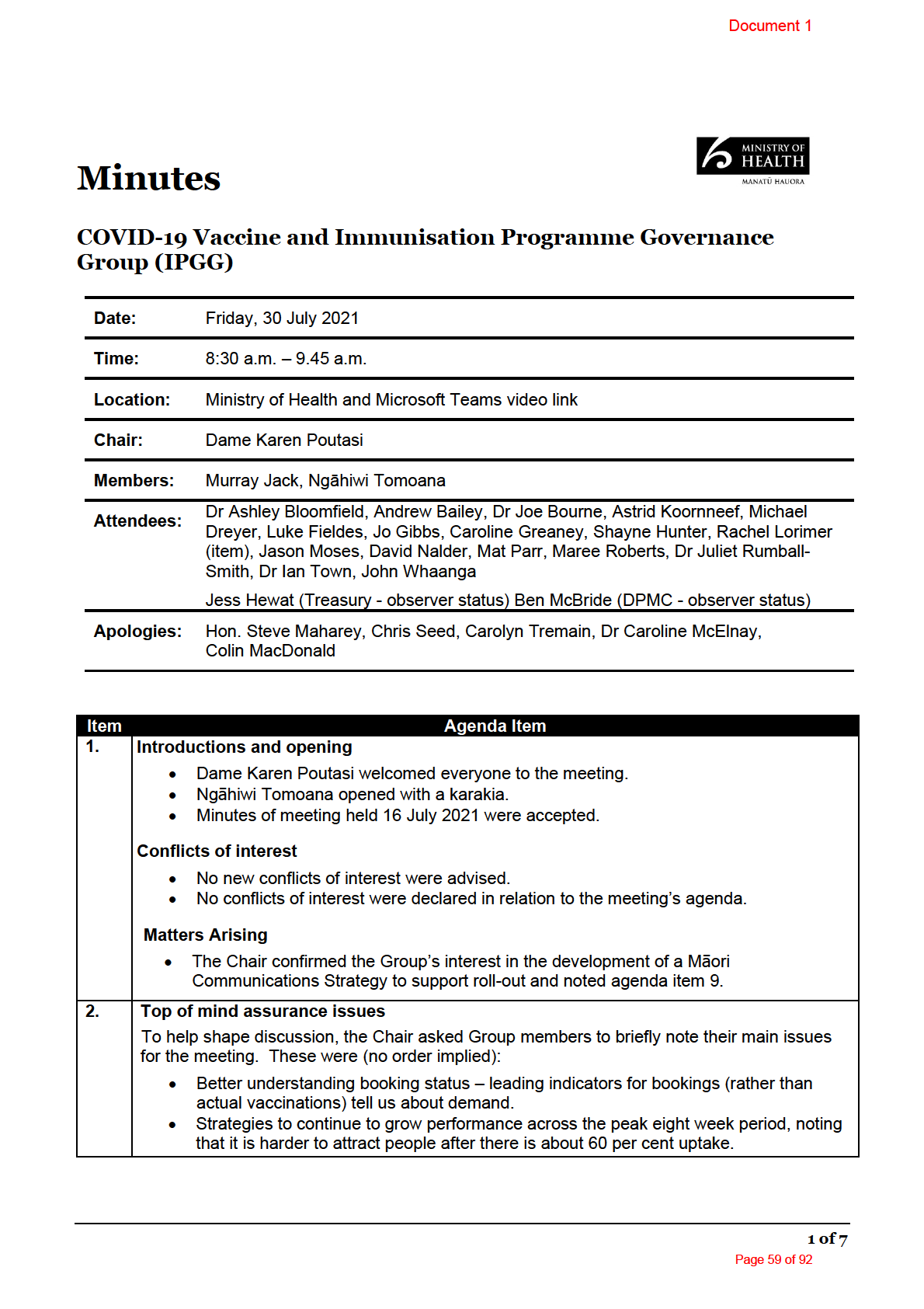
1982
ACT
INFORMATION
OFFICIAL
THE
UNDER
RELEASED
Document 1
• Confidence in delivery – Current delivery about 50,000 doses per day, however, if we
had pressure to go over this and ample supply, how would we deal with this?
Consider resource adequacy, points of delivery etc.
• Equity –
o there is a national push but it is not always translating into results for Māori and
Pacific people. Different DHBs face different issues. We need to understand
what is happening at a regional/local level.
o We need more nuance in how we communicate what the data is showing. The
actual story (Māori and Pacific people in older age groups are being
vaccinated at similar or higher rates to non-Māori, non-Pacific) is better than
the story reflected in public commentary and through production planning.
• Need to balance ‘understanding who the cohort is’ with ensuring the right opportunities
to be vaccinated at provided to these groups. The latest Horizon research shows that
the age group with the lowest intent is 20-40 years. Mass vaccination events may be
an effective way to reach this group.
1982
3.
COVID-19 Immunisation Programme update (Jo Gibbs)
Paper 4: COVID-19 Immunisation Programme Update – 25 July 2021
ACT
• Significant milestones – opening of “Book my Vaccine”, launch of the bookings phone
number, media advertisements targeting the over 60s.
• Another big week for vaccinations, with a seven-day rolling total of 220,000 vaccinations.
• Good data is coming through the “Book my Vaccine” system:
o 62,000 bookings on 29 July 2021.
o 920,000 forward bookings in the system.
• There are 261 primary care service providers (bookings not in the booking system.)
• Now have over 10,000 trained vaccinators. Have taken on additional resource and expect
to have cleared the backlog caused by the process change by 8 August.
INFORMATION
• Solid progress in workplace-based vaccination:
o Mainfreight wil hold a ‘wet run’ on 3 August and Fonterra on 10 August.
o 257 Expressions of Interest received for workplace-based vaccination from a
range of private and public organisations.
• Biggest risk remains achieving equity.
Group discussion
OFFICIAL
• Question were raised about progressing vaccinations for the balance of Groups 1 & 2 and
about the estimated workforce numbers requirements. These were addressed:
THE
o Groups 1 & 2 have ongoing turnover. DHBs have a system to prioritise these
bookings so there is no wait.
o Group 2 reach is good, with first round Aged Residential Care vaccination
completed.
o Most outstanding vaccinations are in Group 3 with some in Group 2.
UNDER
o DHBs with significant maritime ports are working with these ports to ensure access
for workers, noting the aligned mandatory testing regime.
o The Ministry expects to put advice to Ministers in about a week with plans to
encourage and place expectations on the health workforce to be vaccinated, and
to provide options for extending mandated vaccination to this group.
4.
Outcome Measures/Leading Indicators (Luke Fieldes/Astrid Koornneef/Michael Dreyer)
Paper 5: CVIP
RELEASED
Outcome Measures – Status update – data as at 26 July 2021
• This approach to better understanding capacity within the booking system, and interfaces
with DHB production plans, was signalled at the last meeting. We wil report using this
approach from now on.
• Now using HSU (health service utilisation) data produced by the Ministry as the
denominator for uptake measures. This means that, unlike the census data, we have a
known group as the denominator. We can use their gender, age, ethnicity attached to
their NHI and thus build up an accurate view of uptake. This can be analysed by age
band, territorial authority etc. Can help identify where future effort needs to be focussed.
2 of 7
Page 60 of 92
Document 1
• Careful watch on success factor ethnicity. While the current data is showing fairly good
results for those aged over 65 years, it is less positive for younger age groups. However,
this reflects the way the sequencing tool works.
• We aim to have all bookings included in this form of reporting (noting that primary care is
not currently included). Working on an IT solution to this.
• Expected benefits are that DHBs will have better oversight of their regional situation
(bookings, stock in hand, volumes) as smaller sites are brought into production.
Group discussion
• Endorsed the use of tools such as this to give good insights into performance.
5.
Risk Update (David Nalder)
5a.
Paper 6: CVIP Programme risk summary for Governance Group – 27 July 2021
• Reporting is tied to the four Success Framework dimensions.
1982
• Three key risks have been fairly consistent. These are embedding equity, legislative
compliance, and complexity and change. There is now more confidence on certainty of
vaccine supply, which had also been in the ‘key risks’ group.
ACT
• Consideration currently being given to Good Operating Practice performance and
mapping indicators through to risks to allow us to see emerging risks and trends.
• The paper describes all risks and provides a narrative of the programme’s response.
5b.
Paper 7: CVIP Update on recommendations from OAG performance audit report – July 2021
• In May 2017, the Office of the Auditor-General released its report on
Preparations for the
nationwide roll-out of the Covid-19 vaccine.
• The report noted the chal enges of planning for a large-scale immunisation programme,
and made six key recommendations. These covered transparency of communications
across a range of audiences, contingency planning and procuring vaccine s
INFORMATION upply.
• The Health Select Committee has asked the Ministry of Health for an update on its
progress in implementing the OAG recommendations.
General discussion
• Suggested that positioning the response within a wider picture of overall progress with
vaccination roll-out would provide useful context to the Select Committee.
OFFICIAL
5c.
Paper 8: CVIP Proposed Internal Audit Assessments – July 2021
• Seven internal audits are propos
THE ed in coming months to give assurance in the processes
supporting CVIP roll-out.
• Audits in three areas have been prioritised and wil take place August – October 2021.
These are:
o Service Standards assessment
o Technology Gene
UNDER ral Controls assessment
o Logistics assessment.
• Noted that the Service Standards assessment comprises a programme of reviews
touching on DHBs and vaccination sites.
• Both the Steering Group and Governance Group wil receive regular updates on progress
with this work.
General discussion
RELEASED
• Proposed approaches seem sound. However, some questions were asked about timing,
noting the October 2021 completion date signalled for two of the reviews and the fact that
the expected peak vaccination period (i.e. the roll-out programme in which people are
currently involved) wil be completed by this point.
o Unless there is regular interim reporting, there is a risk that the outputs of the
audits may not be able to benefit the programme directly. It was likely to take
about a month to do the work and then a similar timeframe to translate this into
activity.
3 of 7
Page 61 of 92
Document 1
o It is important to differentiate the changes/improvements that wil benefit the
programme implementation going forwards vs those that wil benefit the future
programme. Identified a lot of value going forwards from this work.
• It was suggested that if there was flexibility, consideration could be given to moving some
of this work forward.
• In response to a question, the Programme Director noted that the timing of this assurance
activity had to be considered carefully. Some systems have only just been set up (e.g.
the booking system) and there was a desire to not set too much assurance in place before
these systems were known.’
6.
Strategy for uptake for peak vaccination period (Mat Parr)
Paper 9: CVIP – Maximising Uptake Approach
• While the strong early focus of the programme was on confidence of vaccine supply, this
is now moving to the demand side.
1982
• This paper builds on the research information we have about vaccination wil ingness and
identifies how the programme wil work to achieve 85% vaccination uptake in Aotearoa
New Zealand. It also draws on recommendations from planning workshops held with
ACT
DHB SROs.
o Peak vaccination period wil be September to October 2021. In September there
will be a ‘pivot’ from a servicing a model where most appointments are pre-booked
to a model that services volume walk-ins. We have expanded our geographic
coverage of vaccination site locations. Decisions have included consideration of
travel times etc.
o Equity is a significant consideration. Dif erent groups wil need different service
models. People wil receive invitations through multiple methods.
o Need to avoid complacency due to New Zealand’s unique COVID-free status.
o We are considering the learnings from international experience.
INFORMATION
• Cabinet paper wil be developed for consideration in late August.
General discussion
• Currently we have the planning and the words – the communications and engagement
programme is critical to translate vaccination wil ingness into action/uptake.
OFFICIAL
• In response to a question, the Ministry confirmed that the modelling was mindful of the
quantum of confirmed supply. It has been carefully planned to avoid stock depletion and
the subsequent delivery and confidence impacts this would have. However, the point was
THE
then made that managing the supply curve and pushing appointments out also had risks
(disengagement).
• The Ministry noted the current wider demands on the health workforce – including winter
il nesses, and the fact that many nursing staff have been moved to work in managed
isolation or quarantine facilities. CVIP roll-out must achieve a balance without
UNDER
compromising the rest of the system.
• The suggestion was made simply inviting all Māori and Pacific people from now would
help to promote equity, given age sequencing works against this. The Ministry noted that
full discussions have been had with Ministers and the current approach reflects Cabinet
decisions.
• Reaffirmed the importance of reaching those in rural locations.
RELEASED
4 of 7
Page 62 of 92
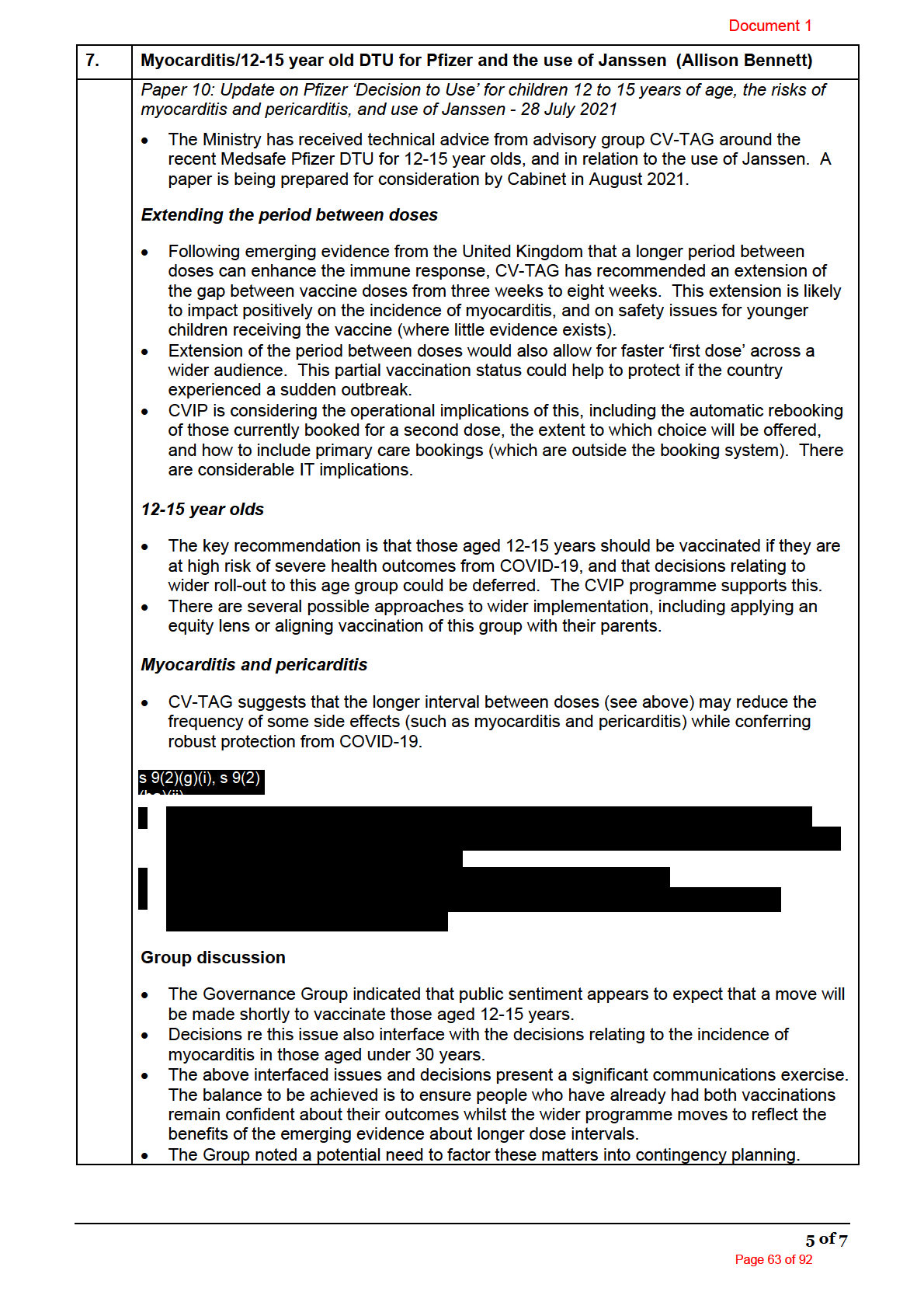
1982
ACT
INFORMATION
OFFICIAL
THE
UNDER
RELEASED
Document 1
8.
DHB Accountability of equity targets (Jason Moses)
Paper 11: District Health Boards Equity Production Plans and Performance
• DHBs are currently at 59% of their delivery against production plans for Māori. This
largely reflects the sequencing framework, and the fact that most Māori are in the younger
age groups.
• Some DHBs are doing an excellent job with Māori aged 55+ years being vaccinated
equitably, however, this is now showing through in current reporting. These DHBs are
ready to move into vaccinating lower age bands.
• DHBs vaccination for Pacific people is generally going very well but some areas stil need
better targeting to lift performance.
General discussion
1982
• Noted that current sequencing pushes equity results out until late in the programme. The
Governance Group asked if the age cohorts for Māori could be lowered to recognise the
younger population composition. This could be restricted to DHBs that have met their
ACT
equity age band targets. Following discussion, it was agreed that the Ministry would raise
this matter at the Vaccine Ministers meeting to be held later that day.
• The recent move to use HSU data as the denominator (see section 4) wil give much
better granularity of populations being vaccinated
• The Ministry confirmed that regional account managers work closely with DHBs to provide
support for targeted communications, including for rural communities.
Action: Discuss at Vaccine Ministers’ meeting on 30 July 2021 whether DHBs that can
demonstrate they have completed/near completed their Mā
ori populations aged over
65 years, and aged 60-64 years, may start to vaccinate their younger Mā
ori cohorts.
INFORMATION
9.
Communications and engagement –
general approach (Rachel Lorimer)
• Current focus on launch of ‘Book my Vaccine’, last part of Group 3 roll-out and Group 4.
• As age banding moves into business as usual other communications wil be developed or
reviewed, such as the ‘FAQ’.
• Currently doing research to understand attitudes of Māori towards vaccination and their
OFFICIAL
vaccination barriers.
• Will also be working with Māori, Pacific and disabilities community representatives to
inform the research portfolio supporting future communications development.
THE
• Current initiatives with an equity focus include, working with Iwi leaders, Māori leaders,
clinicians, and providing targeted funding for champions
Group discussion
• The Governance Group
UNDER noted that there was now better transparency of information
published on the Ministry’s website.
• The Group noted its desire to understand more detail about regional approaches to
promote vaccination uptake with an equity focus, including younger age groups. It
expects the Māori Communications approach will provide this overview and level of
assurance. The Ministry advised it would also prepare a short update of Māori, Pacific
and Disability community engagement, including funding allocations and recipients.
• Following a suggestion from a member, the Ministry confirmed it would publish
RELEASED
vaccination totals daily on the website. It was also suggested that the Ministry consider
publishing the number of bookings made.
• Ngāhiwi Tomoana advised he was pleased to learn of the progress made and the work
being done to advance age bands. He would provide this feedback to the Iwi
Communications Collective the following day.
Action: Prepare talking points for Ngahiwi Tomoana attendance at the Iwi
Communications Collective meeting on 3 August. [Action completed 2 August]
6 of 7
Page 64 of 92
Document 1
Action: Prepare an update of Māori and Pacific communications and engagement to
date, including funding allocations.
Action: Vaccination totals to be published on the Ministry’s website on a daily basis.
[Action completed] https:/ www.health.govt.nz/our-work/diseases-and-conditions/
covid-19-novel-coronavirus/covid-19-data-and-statistics/covid-19-vaccine-data#by-day
Action: Māori Communications Plan will be put to the meeting of the Governance
Group on 13 August 2021.
10.
Other business
• The Chair noted that Mat Parr was moving to a new role and thanked him for his
contribution to the CVIP Programme over the past several months.
• Noted that Fiona Michel wil lead the ‘strategies for uptake’ workstream going forward, and
Matt Jones wil lead the ‘transition to future state’ work.
1982
11.
Sum-up of Governance Group’s focus areas for the programme arising from meeting
• Challenges remain, but the programme has made considerable progress. The launch of
the booking system was a significant achievement. Bank the successes while bein
ACT g
mindful of the challenges ahead.
• There is a need for a strong focus on Communications and Engagement to retain
confidence and momentum in roll-out:
o changes to sequencing or population groups,
o changes to vaccination delivery,
o to promote vaccination uptake,
o to meet equity objectives.
• Internal assurance activities must meet the needs of the programme both for ‘real time’
and for legacy reasons.
INFORMATION
12.
Meeting close
The meeting ended at 9.45 a.m. due to the prior commitments of several members.
John Whaanga closed the meeting with a prayer.
13.
Next Meeting
Friday 13 August 2021, 8.00 a.m. – 10 a.m.
OFFICIAL
THE
UNDER
RELEASED
7 of 7
Page 65 of 92
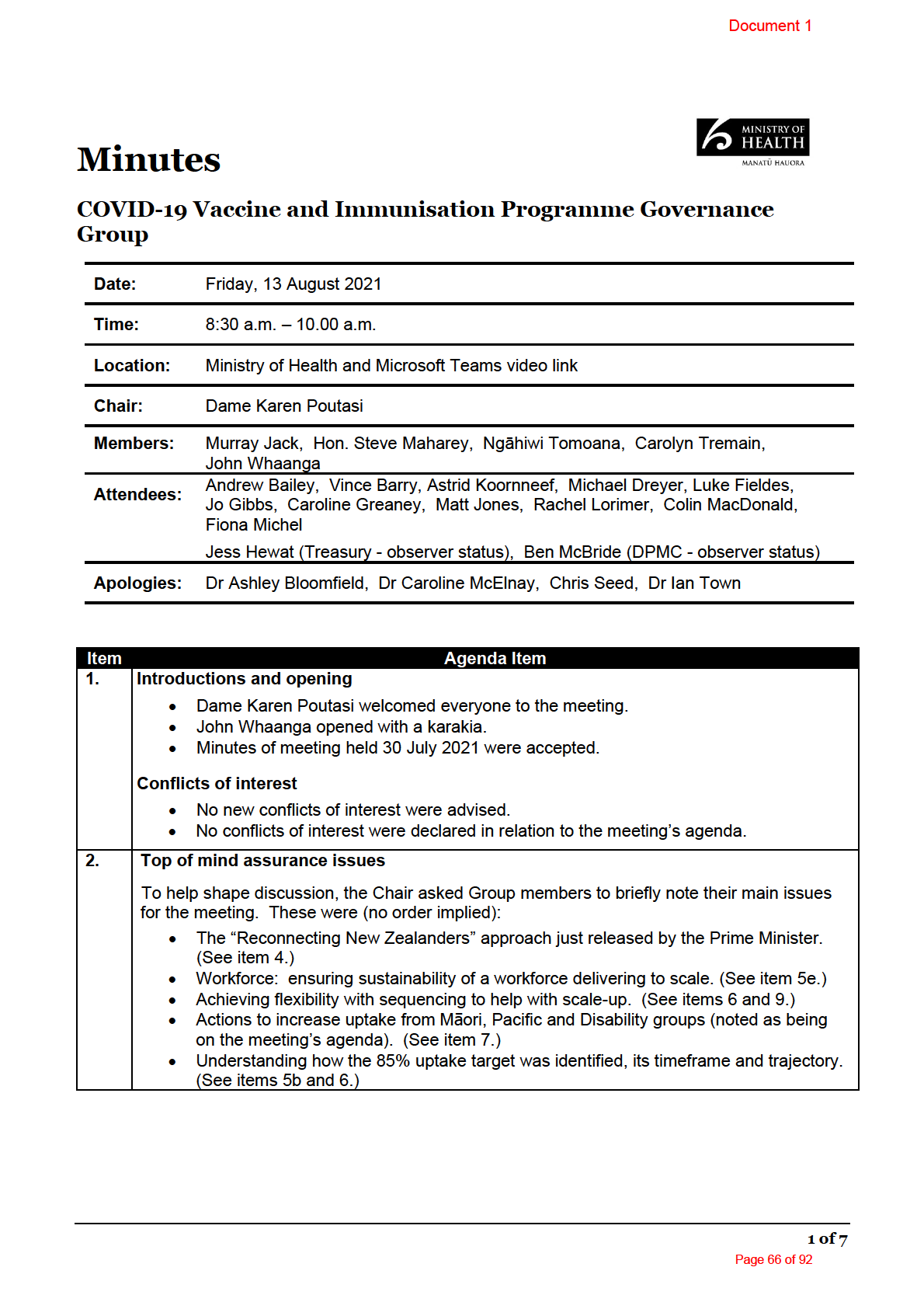
1982
ACT
INFORMATION
OFFICIAL
THE
UNDER
RELEASED
Document 1
2. Other issues
Cont. • Two members noted positively their own personal experience of COVID-19 vaccination.
• The Chair noted she was mindful that the Governance Group must add value to the
programme. As the Ministry continued to strengthen and assure of its ability to deliver the
programme into the future, a review of the Group’s role would be appropriate.
Action 1: Director-General to work with the Chair to review the future of the CVIP
Governance Group at an appropriate point.
3.
COVID-19 Immunisation Programme update (Jo Gibbs)
Paper 4: COVID-19 Immunisation Programme Update – 08 August 2021
• A number of significant announcements this week:
1982
o Announcement of change to the interval between doses (21 days out to six
weeks). Messaging appears to have been well received with only a small peak in
calls at the call centre. Call response times kept to within a minute.
ACT
o Announcement that DHBs who had completed sequencing vaccinations and had
capacity could move to lower age bands early. This was well-received by DHBs.
• Another strong week for vaccination volumes.
• Primary care: DHBs with maritime ports wish to offer vaccination to all port workers, not
just those covered by mandatory testing regime. Wil be discussed with Vaccine Ministers
later that day.
• Small additional supply received from Pfizer means we have been able to build up a
seven-day stock. We have been able to give DHBs some flexibility but continue to
monitor supply closely.
• Have met with Minister Henare re equity planning; also met with ethnic com
INFORMATION munity
leaders. Focus now is to maximise uptake across rest of the year.
• Cabinet wil consider options re vaccination for 12-15 year age group on 16 August. One
option is to allow early entry for dependents accompanying parents. There are
operational implications (including informed consent procedures) to be worked through for
12-15 year olds seeking vaccination by themselves.
OFFICIAL
4.
Reconnecting New Zealanders
Papers 5 and 5a: “Reconnecting New Zealanders to the World” and Prime Minister’s media
release – 12 August 2021 THE
• The Prime Minister outlined five key areas of focus for reconnection, with vaccination
playing a key role. Announcement made that all eligible age groups wil be able to book
their vaccine by 1 September 2021. The elimination strategy wil continue to apply.
• Noted that the Strategic
UNDER COVID-19 Public Health Advisory Group led by Sir David Skegg
had just released three reports on New Zealand’s future strategic approach to managing
COVID-19 and reopening the country.
Group discussion
• In response to a question the Chair advised that the Governance Group and the group led
by Sir David Skegg did not have direct links. However, a government agency CEO group
meeting chai
RELEASED red by the chief executive of DPMC has been updated about the strategic
advisory group’s work.
2 of 7
Page 67 of 92
Document 1
5.
Programme focus areas (workstream leads)
Paper 6: Programme focus areas – 11 August 2021
5a.
Delivering to scale (Vince Barry)
• Programme is reviewing DHB production plans between now and September. Target is
50,000 doses/day delivery on smooth cadence. Logistics are critical to support this.
Mindful of potential impact of external influencers (e.g. wider workforce issues).
• Maintenance of clinical safety is critical. Must also ensure that any issues that arise within
COVID-19 vaccination do not appear more widely.
• Encouraged by the involvement of many primary service providers, including pharmacies,
who view their involvement in scale-up and roll-out very positively.
• Technology: must ensure all key enablers are in place to support scale. Paper being
drafted for Steering Group consideration on this issue.
5b.
Strategy for Uptake (Fiona Michel)
1982
• Noted 85% vaccination target set having regard to research in New Zealand and
international settings.
ACT
• About 20% of primary care providers are delivering vaccination. Larger practices have
been onboarded first. Working to include all primary care providers by end October to
give resilience going into the new year. However, this second group comprises smaller
practices with a smaller overall population coverage.
• All DHB providers have their own uptake strategies through their production plans and
equity plans. Performance is actively monitored by the Ministry.
• CVIP is aware that other countries variously offer incentives for uptake and is reviewing
their approaches.
• CVIP national director indicated that the cross-sector perspectives of Group members on
the draft strategy for maximising uptake would be beneficial once draft is completed.
INFORMATION
Group discussion
• The Governance Group noted that the current response to COVID-19 by “all of Aotearoa
New Zealand” leaves a legacy of built social capital and of trust at a government level, at
a service provision level, etc. New Zealand’s unique situation is a significant ‘prize’ for all
New Zealanders, and adding incentives to inspire individuals to essentially ‘save their own
lives’ seems inconsistent.
OFFICIAL
• We must connect with the right people to promote and enable uptake. The importance of
connecting with local leaders to lead local approaches to reach local communities was
emphasised. The role of the cent
THE re is to support this.
(See also discussion at sections 7
and 8.)
5c.
Stakeholder engagement (Caroline Greaney)
• Need to build and maintain the confidence of our key stakeholders.
UNDER
• Effective engagement is key to ongoing success of the programme.
• Reviewing and refreshing our stakeholder map, and engagement learnings to date, to
identify gaps and opportunities to take forwards into future engagement.
• Currently looking at cross-agency relationships that wil strengthen work with disability
communities
.
5d.
Future State design (Matt Jones)
RELEASED
• Building an assumptions map and a future state operating model for COVID-19
vaccination from 2022.
• The aim is to be able to apply the final product to other vaccination programmes.
Group discussion
Noted the challenges of designing this in a changing landscape, where the science is not yet
fully understood.
3 of 7
Page 68 of 92
Document 1
5e.
Worker vaccination (Fiona Michel)
Workplace vaccination
• Both Fonterra and Mainfreight have completed their first round workplace vaccination with
very good uptake.
• Good response to the request for expressions of interest from other workplaces interested
in offering this service to their workers. These are now being assessed.
• Next priority wil be supermarkets as essential service providers.
• As the government’s wider vaccination approach is to implement age sequencing,
workplace vaccination has been run in parallel.
Mandatory worker vaccination
• Port workers: There have been some pockets of resistance from this worker group. Work
1982
going on to support port employers to have port workers vaccinated including establishing
port-based clinics (commencing shortly).
• Noted that vaccination is now being offered to all port workers whether or not they are
ACT
covered by a mandatory vaccination order.
Group discussion
• Workplace: Noted that there is a wide group of essential service providers at AL4 (e.g.
couriers, power companies, funeral directors) and this group should be assessed to
identify those who must be offered vaccination as an absolute priority.
• Courier companies and those servicing supermarkets are likely to be of higher priority.
Noted that, mindful of the threat posed by the Delta variant, the all-of-government group
led by DPMC was doing some work around the scope of essential service
INFORMATION providers.
• Port workers: Members noted the public reaction to non-vaccinated workers involved in a
previous outbreak. Also noted that the requirements for mandatory testing are phased,
with the last cohort (including some port workers) not required to have completed
mandatory testing until 30 September 2021. In the meantime, members were aware that
maritime port employers were looking at how they could reduce risks in their workplaces
OFFICIAL
e.g. through limiting interactions of certain groups.
(Note: The Group’s discussion on this issue fed into its wider discussion on New Zealand’s
THE
preparedness for a Delta outbreak – see section 8.)
5f.
Vaccinator workforce (Fiona Michel)
• Now have 10,800 trained vaccinators. About half used in the programme to date.
• COVID-19 vaccinators:
UNDER NZQA has approved the training programme. Thirteen people
have met all requirements and are now in the vaccination workforce. 370 people in
training. Initiative positively received by many DHBs/providers. Māori providers were the
early adopters. There is a lot of interest in the legacy potential of this role.
• Vaccinator authorisation: Initial backlog (380 applications) created by the temporary
deferral of authorisation is cleared.
Hands up (surge) database
RELEASED
• Mindful of the undeployed skil set and wider trained capacity in the network. CVIP
therefore now has a dedicated sourcing role to work closely with DHBs and link resources
to them to address need.
• Looking to maximise use of the “Hands up” database by opening up access to providers
more broadly than DHBs. Noted this is still subject to discussion with DHBs.
4 of 7
Page 69 of 92
Document 1
5f.
Group discussion
Cont. • The Group noted positively the legacy work associated with the COVID-19 vaccinator role
and suggested that consideration by given to micro-credentialing these workers to
perform other roles.
• In response to a question, the Ministry confirmed that the timeframe to authorise a new
COVID-19 vaccinator is about a week, providing all correct information is received with the
initial application.
Action 2: Ministry to consider the following for CVIP legacy activity:
a) Consider what micro-credentialing can be done flowing out of the creation and
appointment to the COVID-19 vaccinator role, and
b) Consider how the COVID-19 vaccinator role might endure into the future.
5g.
Workforce sustainability (Group-led)
1982
• Group members noted it was important that the programme can demonstrate that it has
considered the impacts of both scaling-up and prolonged roll-out on the vaccination
ACT
workforce, and that it has taken steps to help to DHBs and other health workforce
employers to manage this.
• Consider actions to keep the essential workforce ahead of the curve, for example, early
vaccination of those in essential services not covered by mandatory vaccination.
Ministry comment
• Aware that many employers are working hard to ensure that vaccination staff maintain
normal working and leave patterns. The Ministry understood this approach is also applied
more broadly across the wider health workforce. Also noted that those in vaccination
INFORMATION
roles were rotated to other related roles e.g. monitoring those in the waiting room.
Action 3: Consider if the Ministry should provide ‘detailed actions’ guidance to
support employers to keep their vaccinator workforce fresh. [Fiona Michel]
(Note: The Group’s discussion on this issue fed into its wider discussion on New Zealand’s
preparedness for a Delta outbreak – see section 8.)
OFFICIAL
6.
Reporting against the Success Framework (Luke Fieldes)
Paper 7: CVIP Outcome Measures – 13 August 2021
THE
• Tracking well on measures other than efficiency. Reasons for poorer performance in
efficiency are that some DHBs have not been able to keep pace with planned capacity
increases, and some have not matched demand. (Noted however that the speed of the
new age band releases may have had an impact on performance.)
UNDER
• Forward bookings are largely second doses; actual vaccinations are largely first doses.
• Noted that the data increasingly provides evidence about gaps in uptake. For example, in
group 3 there is a significantly higher uptake by people aged 65+ years with at least one
long term condition (LTC) than by those without an LTC. This potentially shows that
engagement is having a positive impact for this group. However this is not the case for
the 16-64 year age group with LTCs.
• Noted that some DHBs have started to run out of people in the released age bands.
Vaccine M
RELEASED inisters have agreed to implement 10-year bands in response and this has
been well received by DHBs.
• Acknowledged that current data is sourced from the booking system and thus excludes
primary care.
Group discussion
• The Group noted positively the type of data now able to be provided and the ability to
pinpoint gaps.
5 of 7
Page 70 of 92
Document 1
• It was queried how CVIP was ‘holding’ DHBs to the announced sequencing framework.
Some DHBs appeared to apply more flexibility.
• Closely informs what is needed from Māori and Pacific engagement. But also shows that
some groups wil need more than just messaging to prompt action.
• In response to a question, the Ministry advised that this data was not yet readily available
to DHBs due to the recency of the change to using HSU data as the denominator. The
Ministry was working to transfer DHB data over.
Action 4: Provide the Governance Group with information on the specific actions that
CVIP wil do differently to address the evident gaps showing up in the data. [Fiona
Michel]
7.
Māori and Pacific Communications (Rachel Lorimer)
Paper 8: Communications approach for Maori, Pacific and Disability – 12 August 2021
The Governance Group noted its desire to understand both the broader strategies and the
1982
targeted regional approaches to promote vaccination uptake with an equity focus.
• The Ministry noted that there is no ‘one size fits al ’ approach to engagement. The
ACT
mainstream campaign and funding activities are enhanced by regional and local
communications and engagement activity, led within those communities, and variously
targeting Māori, Pacific and Disability communities and those in younger age groups. The
Ministry has made funding available for many of these local initiatives.
• Ministry feels confident that it has strong networks and capability, and is reorientating
messaging to support strong uptake.
• Noted that local iwi groups are very well engaged.
• Digital campaigns and tools wil start to gain more prominence as open age banding
commences from 1 September 2021. Confirmed that some of these initiat
INFORMATION ives wil be
appropriate for Māori audiences.
• The Ministry undertakes ongoing work to address misinformation where it arises.
Group discussion
• Members discussed the critical importance to scale-up of matching comms and
OFFICIAL
engagement initiatives to the audiences.
• They sought assurance that the Ministry felt it had the right communications strategies
and tools ready for the 1 Septem
THE ber launch.
• Members noted that positive role models and leadership, coupled with continuous positive
promotion, are proving very effective, particularly in smaller communities:
o Community leadership and community spirit in Wairoa has seen over 70 per cent
of the population have their first dose.
o One member had
UNDER helped provide confidence to a group of workers in his
community simply by being vaccinated in their presence.
o Tribal events create opportunities to increase uptake by Māori.
• Members queried CVIP communications preparedness for the changes to the interval
between doses, announced the day prior on 12 August. The Ministry advised that it was
comfortable that direct engagement had taken place with the Iwi Communications
Collective and the Cause Collective to target Māori and Pacific communities. There would
also be a s
RELEASED trong ‘push’ through social media.
• Noted positively the freeing up of age bands from 1 September.
• As an overview, the Group noted there must be a strong link between ‘awareness’ and
‘action’, and there must be agility to respond in areas where resistance is encountered so
that effort still translates into uptake. Leading indicators now give a granular view of
forward bookings. If the effort does not show through in leading indicators then a
significant rethink of engagement wil be a priority.
• (Note: The Group’s discussion on this issue fed into its wider discussion on
New Zealand’s preparedness for a Delta outbreak – see section 8.)
6 of 7
Page 71 of 92
Document 1
8.
Contingency planning for Delta outbreak (Group-led item)
• Members expressed the view that arrival of the Delta variant into New Zealand was a
‘when’ and not an ‘if’, noting the current situation in NSW.
• Considerable discussion took place about the country’s preparedness for the Delta
variant, including contingency planning measures, and the actions that can be taken now.
• Whilst noting the nation’s performance to date, the Delta environment was very dif erent to
that which existed in early 2020 and it must not be assumed that the mechanism that has
reliably delivered to date wil remain effective. To what extent does the approach in the
future programme still reflect the situation of early 2020. There is now a need to advance
thinking against future risks - what wil we do significantly dif erently in order to address
Delta?
Vaccination readiness
1982
• Under AL3/4, essential services remain open. Members are strongly of the view that
workers in these services, whether or not subject to mandatory testing, should be fully
vaccinated well ahead of the current vaccination curve, and should receive their first dose
ACT
as soon as possible. Members expressed the view that for many, they did not think a
second dose would be possible before Delta was detected in New Zealand.
• Port workers were of particular interest to the group. However the scope of essential
services could usefully be reviewed and broadened from a vaccination perspective.
• It was queried if planning allows for vaccination to continue in an area exposed to the
virus. One member suggested this was something that the AOG group was already
considering.
All-of-government readiness
INFORMATION
• The Chair noted that, from an assurance perspective the Governance Group does not
have visibility of the intersect between the vaccination programme and the separate
testing programme also led by the Ministry. This ‘joined up’ overview was something the
Governance Group indicated it needs to support its wider conversations with and
assurances to Ministers.
OFFICIAL
Action 5: National Director to link with Carolyn Tremain re the all-of-government
interface, and to clarify the vaccination/testing interface within the Ministry, for report
back to the Governance Group.
THE
9.
Sum-up of Governance Group’s focus areas for the programme arising from meeting
• Members of the Governance Group noted their strongest interest area and concern at this
point was the whole-of-government response to a Delta variant outbreak, and the actions
that can be taken now from the vaccination perspective to help to protect New Zealanders
from COVID-19. The im
UNDER plications for New Zealand of another COVID-19 outbreak are
now much broader than just having the disease in the community.
• Achieving equity remains a focus for the Group. We must trust local approaches in local
communities. The most effective actions wil be a combination of Ministry-led
communications and engagement activities that supplement the actions of local trusted
community voices who can push reach and strengthen acceptance.
10.
Meeting close
RELEASED
The meeting ended at 10.00 a.m.
Ngāhiwi Tomoana closed the meeting with a prayer.
11.
Next Meeting
Friday 27 August 2021, 8.00 a.m. – 10 a.m.
7 of 7
Page 72 of 92
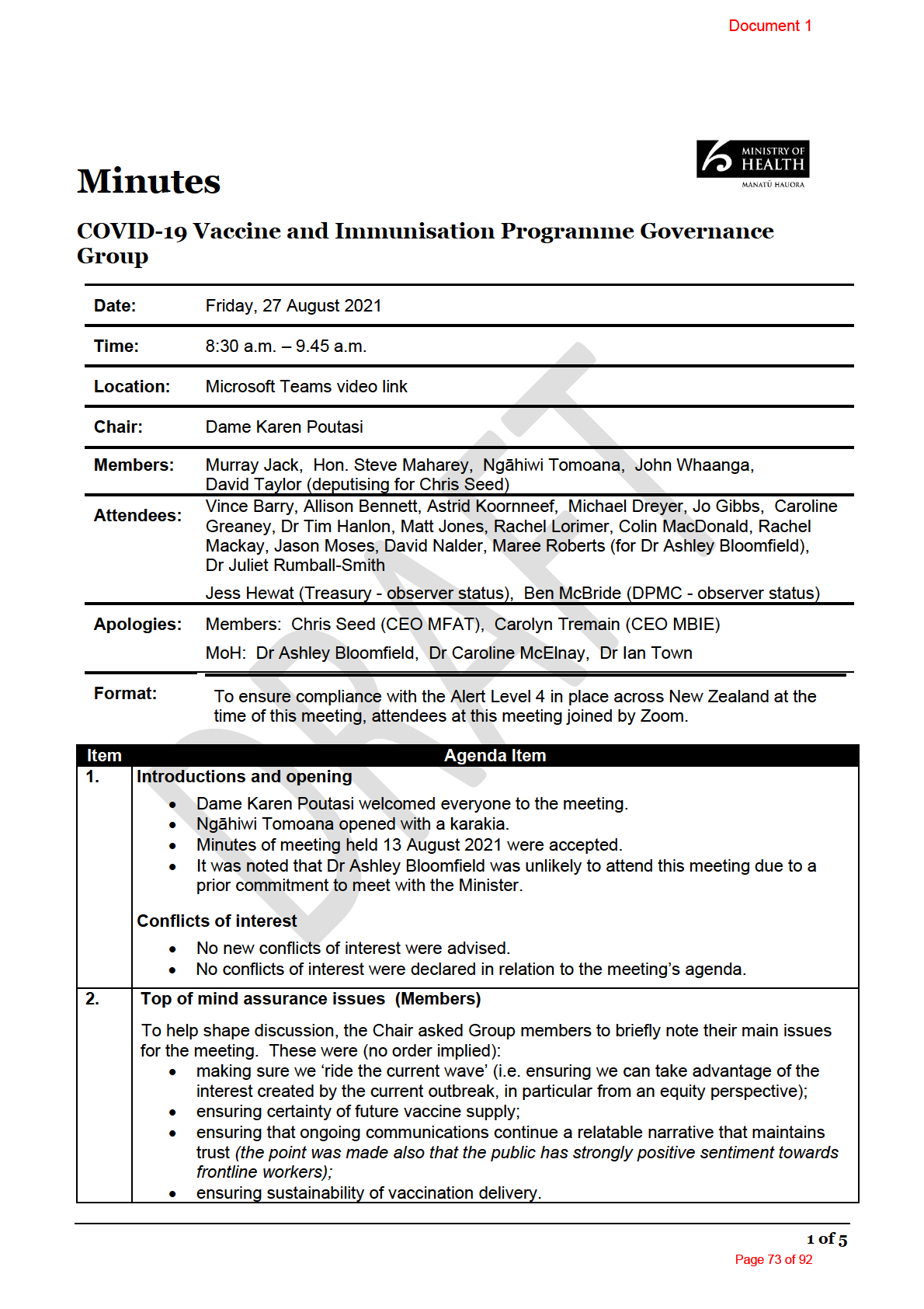
1982
ACT
INFORMATION
OFFICIAL
THE
UNDER
RELEASED
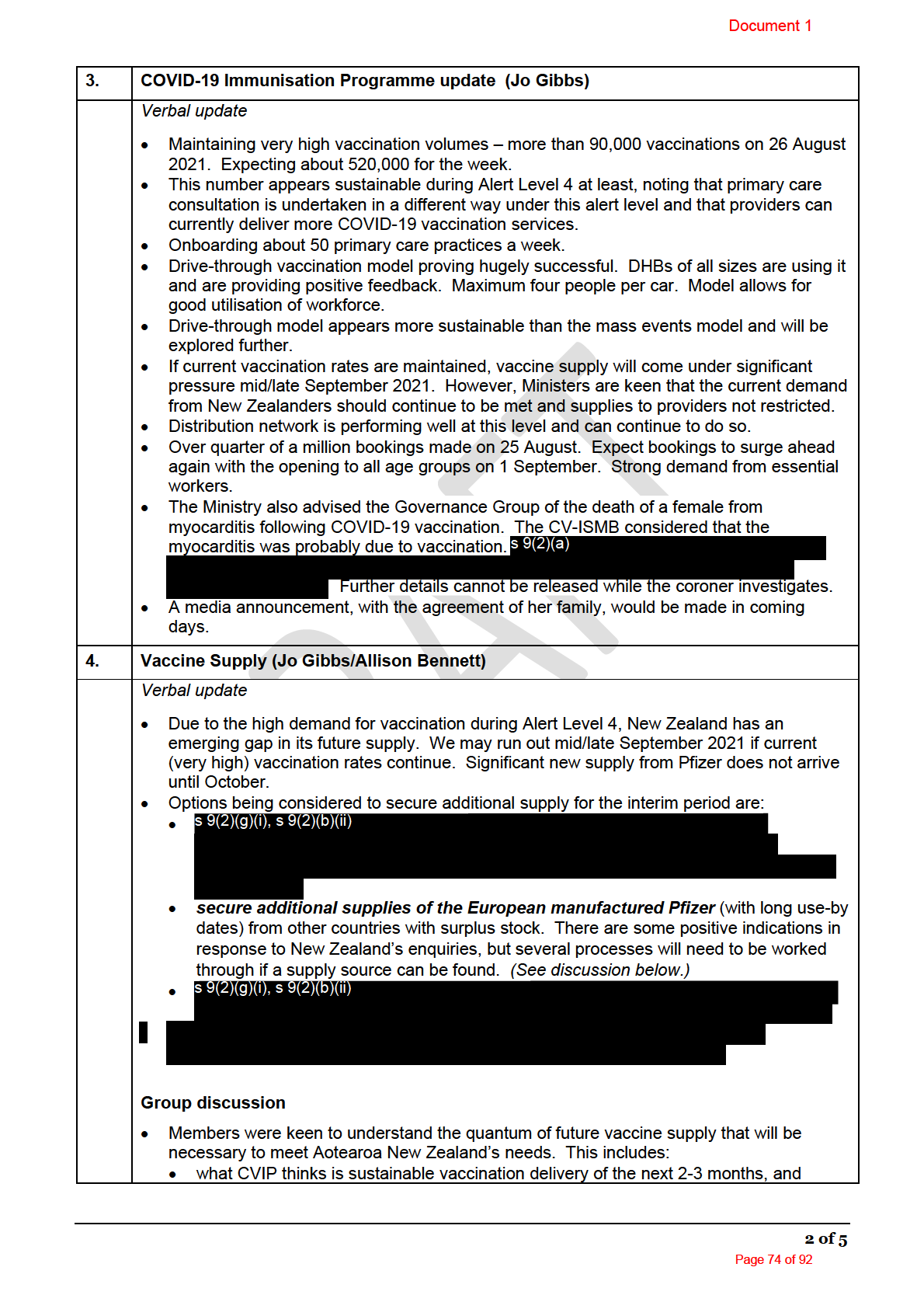
1982
ACT
INFORMATION
OFFICIAL
THE
UNDER
RELEASED
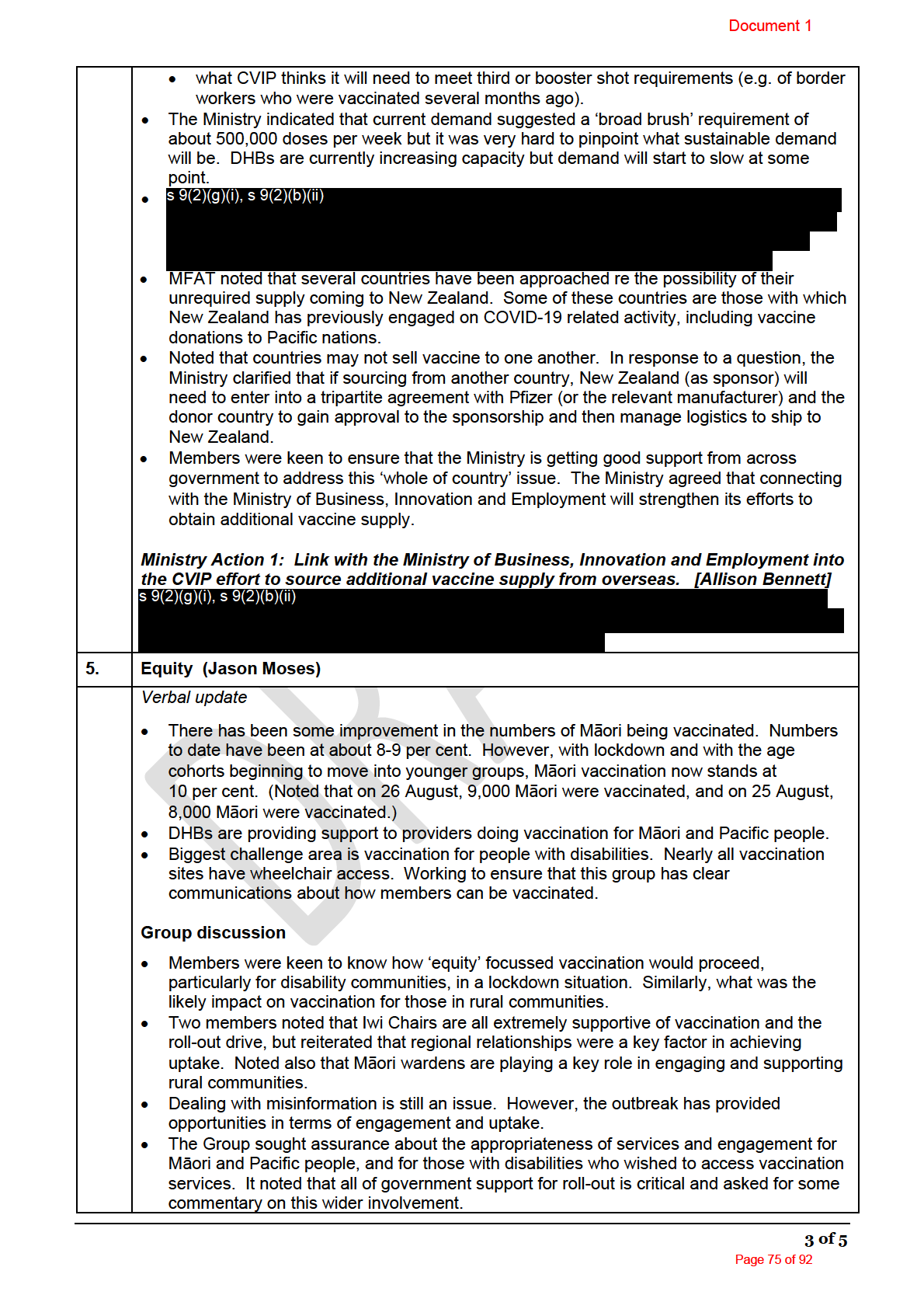
1982
ACT
INFORMATION
OFFICIAL
THE
UNDER
RELEASED

1982
ACT
INFORMATION
OFFICIAL
THE
UNDER
RELEASED
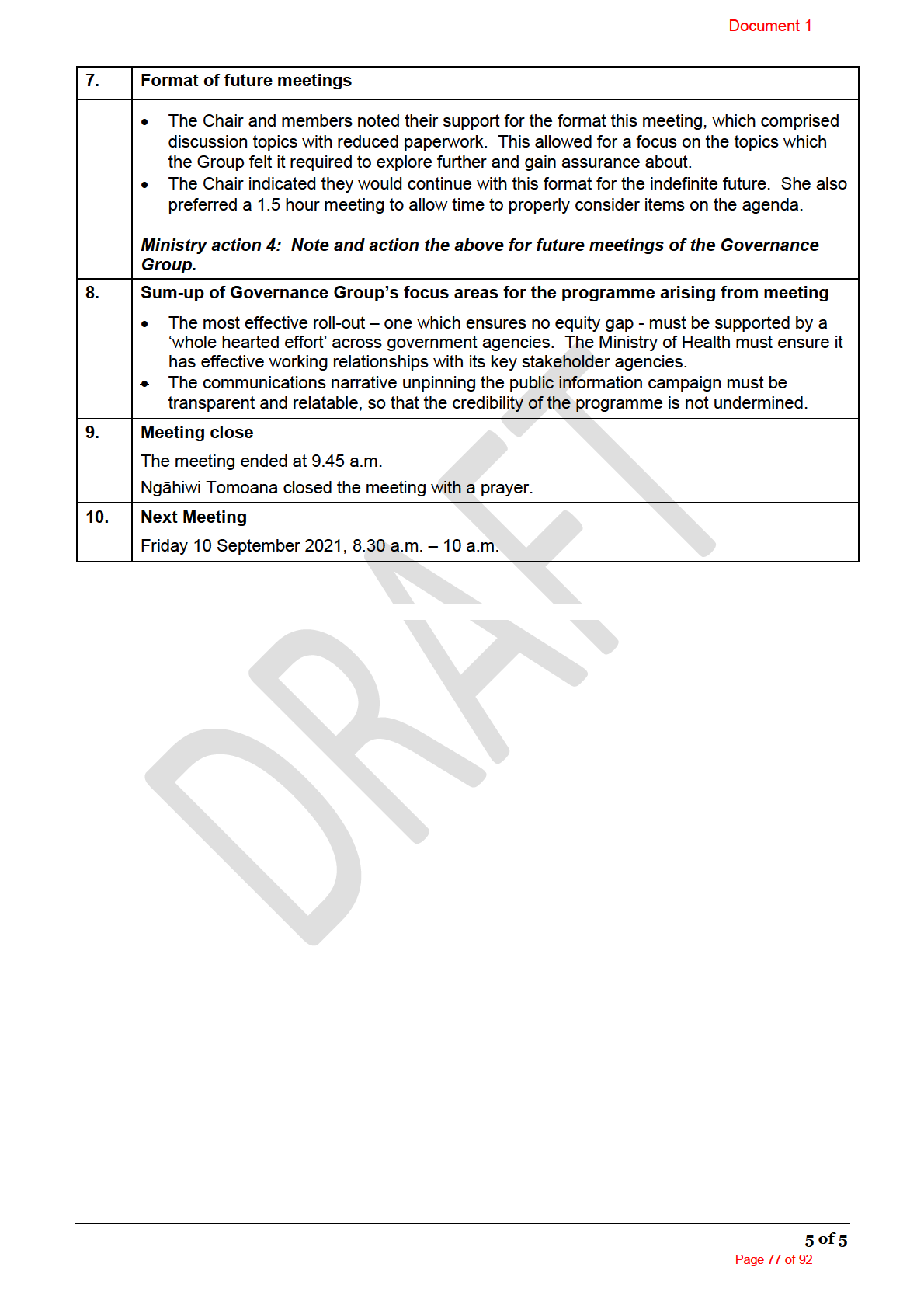
1982
ACT
INFORMATION
OFFICIAL
THE
UNDER
RELEASED
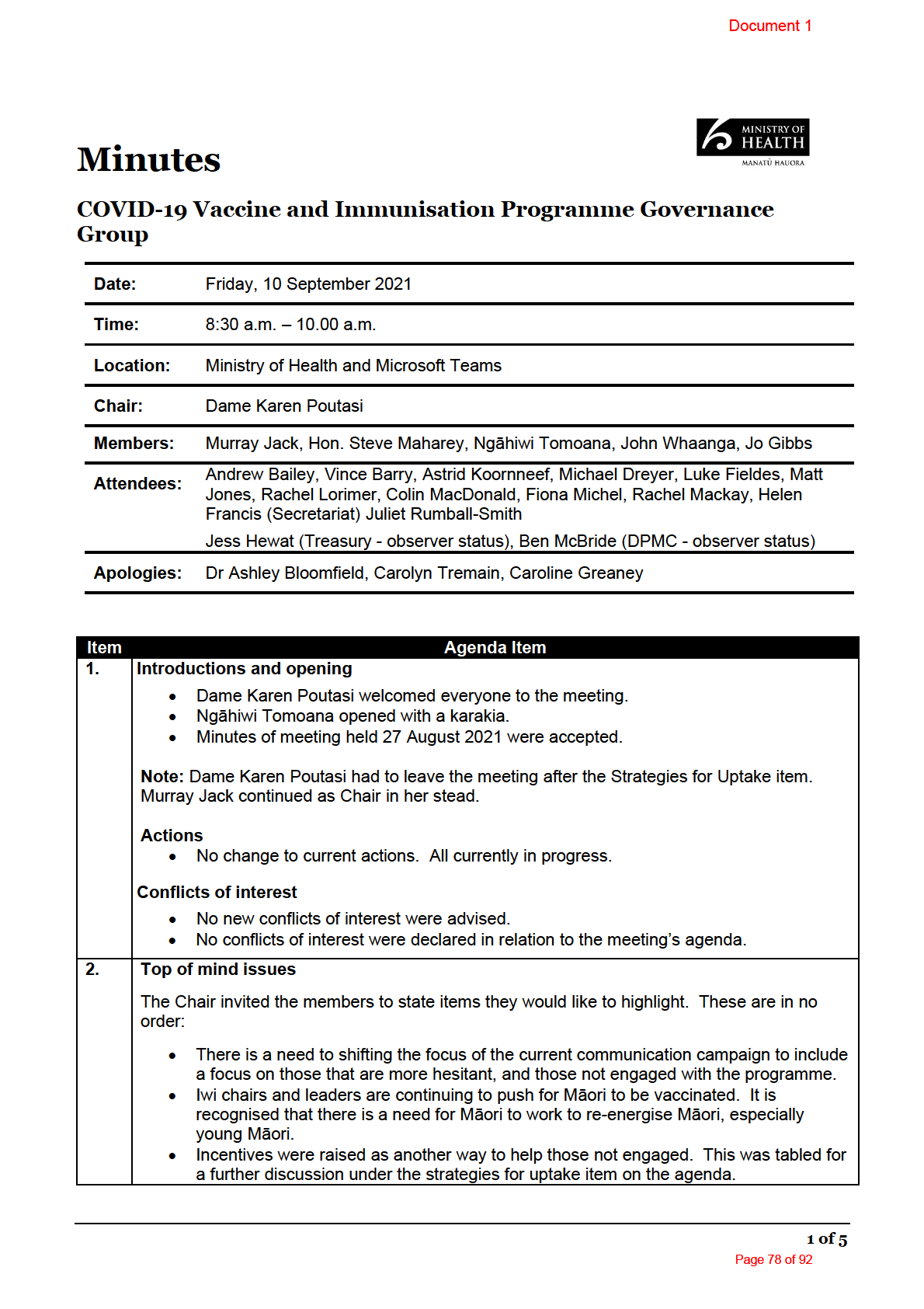
1982
ACT
INFORMATION
OFFICIAL
THE
UNDER
RELEASED
Document 1
• The Ministry recognised our strategy is to vaccinate as many people as possible and
not set a target percentage.
• It is recommended not to leave the hesitant and unengaged part of the community
until last and that we should focus communications on these groups specifically.
• Ministers are requesting further information, in particular equity data. We are
continuing to pull out all the stops to assist our political champions for the programme.
• There is concern about younger age groups being vaccinated as the bulk of the
population is under 40 and a significant group is under 25. We should be tailoring our
communications campaign to these groups.
• A more focussed partnership with Iwi chairs and Ministers, who are strongly supportive
of our approach and vaccination programme, should be utilised moving forward.
• It is acknowledged that there is 6 or 7 workstreams working in this area but that they
are not as well connected as they could be. There are also some great methodologies
that we could take into the wider vaccination programmes if achieve the legacy.
1982
Action: Ability to utilise current methodologies and opportunities to create a legacy for the
wider vaccination programme moving into the next year. Chair to discuss with the Director-
General and add an item for next meeting. (Dame Karen Poutasi)
ACT
3.
Vaccine Supply (Jo Gibbs / Al ison Bennett)
• The item under Strategies for Uptake on the agenda wil capture most of the areas of
this item.
• Vaccines landing at 11:20am this morning. The logistics and operational plan for this
wil see customs work and release these by 5pm tonight and then provide additional
supply to Auckland arriving Sunday morning.
• There is another deal underway from Europe for 500,000 doses. This
INFORMATION will be
announced next week and wil run with the same process as the recent delivery.
Batch numbers have been approved by Medsafe and the Bilateral agreement is ready
to be signed.
• Pfizer has agreed to send 200,000 more doses which wil arrive between September
and October.
• The Ministry would like to note that although numbers of vaccinated people appear to
OFFICIAL
be reducing, 65,000 doses were completed last week, and the data indicates this is
due to the reduction on alert levels.
• This weekend there is a full communications campaign expected and walk-in clinics
THE
will be available.
• Technology is working on identifying areas through the book my vaccine app to enable
the public to see digital maps of where walk-ins are.
• Geospatial data is available now and we see that rural areas have a lower turn out
that urban areas. We can see specific small rural areas have done well as these have
UNDER
been targeted, however larger rural areas closer to urban areas have not as there was
an expectation, they would travel into urban area clinics, but this has not happened.
Strategies to lift uptake wil be discussed in the next agenda item.
• There was a debrief with the IMT team recently where being clear on urban, rural,
younger people, equity, Māori and Pakeha strategies was highlighted.
The Chair and the Ministry recognise, and is very grateful, for the effort undertaken by MFAT,
MOH and all those working around the clock to complete the policies and logistics required, to
RELEASED
produce such an amazing achievement. Congratulations to the team for securing doses and
responding so well under the scenario of trying to vaccinate at the same time as an outbreak.
4.
Strategies for Uptake (Fiona Michel / Jason Moses)
(This item was meant to be presented fifth but was switched during the meeting)
• This has been reprovisioned as was previously part of Mat Parr’s role who is no longer
working on the programme.
2 of 5
Page 79 of 92
Document 1
• There has been a new working group created to look at this with the optimisation team
looking at the day to day working.
• This working group wil assist us to see any pain points through great data. We’l be
able to understand what is happening in areas, proving expert support when required.
• We are actively looking into taking ideas around incentives to the next steps. We’re
working with the wider vaccination programme to understand how they’ve used
incentives in the past. Currently it looks more like enabling wil work better, that’s
providing transportation and connecting with like-minded groups, including workplaces
and a mixture of private and public services to help with delivering vaccinations.
• There are lots of workplaces working hard to provide vaccinations for their employees.
• Ministers have been advised by the Ministry that an extension to the health order to
see how it covers all of New Zealand should be considered along with a more granular
personalisation.
• Data can be used to see who isn’t responding to invites to be vaccinated so we can
reach out to these areas. There is a Mr Whippy model being discussed where we
1982
show up in the street and work with people locally.
• There is an alternative to Pfizer vaccine available as it may be that people want to be
vaccinated but not with the Pfizer vaccine. We are considering how best to approach
ACT
this group of the community to offer an alternative.
• We need to stay connected to our communities and Māori health providers as there is
a lot of value here, including if we need to move quickly as we saw during the
lockdown.
• There is a large focus on communications in these areas from Rangatahi and Iwi
communications collective and a specific target response for Māori given that’s one of
the key gaps at the moment. Providers are also looking into incentives and some
have already implemented these in their communities.
• It is encouraging to see momentum in this space and personalisation of this is likely to
have the biggest impact on vaccination rates. Communications need t
INFORMATION o shift to get
that last 20-30%. We need to experiment and be more proactive. Providers wil need
data to see who hasn’t been vaccinated in their areas so they can communicate with
them directly.
• We suggest that all government agencies, when communicating with people, should
be asking, have you had your vaccine yet? Having employers do this would also be
helpful.
OFFICIAL
• There are workplace debates starting and we are looking at possible Health & Safety
legislation conflicts.
• Ministers wil be lobbied about
THE workplace vaccination and Health & Safety legislation.
• Any assistance we can provide across the government to remove barriers including
information sharing and legislation nature should help to ease some of these.
• One of our biggest opportunities for equity is in providing walk-in vaccination clinics
and next week these wil open to everyone.
• We have a very good c
UNDER ohort of people for each age group and ethnicity health
utilisation database, so we know who hasn’t responded. With data we can look at the
area, post code, ethnicity and can target our approach.
• We have done personal invitations as the dif erent age groups have rolled out and we
are supporting different ways of communicating and seeing what people might be
more likely to engage with.
• Talking to social science experts will identify techniques to bet er communicate with
communities, including through community based discussions to assist in mobilisation.
RELEASED
• There are 136,000 out 900,000 Māori not affiliated to an Iwi. We need to look at a
personalised approach for this group especially as 8-9000 don’t have easy access to a
provider.
• The Communications Campaign is reorienting themselves to a new phase. Our
approach has done well up til now and the next phase is segmentation and specific
messages to individual groups, including stakeholders and those on the ground who
need to hear from us.
• We are reviewing behaviour and interventions also and strengthening our messaging.
Information on safety, protecting yourself, whānau and reconnecting with the world are
3 of 5
Page 80 of 92
Document 1
key focus points along with interconnecting sites and moving quickly to utilise touch
points.
• MSD have fliers going into foodbanks during lockdown. Electoral commission is
helping to target small communities. We are continuing a broad approach and also
targeting under 30s through more shareable channels to get through to youth,
including the radio. We are looking at geographical data to specifically target radio to
these areas.
• Emotional communications work well. Our previous messaging about recycling
rubbish, seatbelts, smoking created huge influences in our children. The children
influence adults to make changes. How do we use that influence and the effects of
children as we did on earlier campaigns?
• There are some negative messages out there, how do we turn these around to
positive messages? Iwi chairs and Māori health providers are able to go into Māori
communities and partnerships. We should be utilising this much more. Targeting
100% vaccination rates by Christmas for Iwi. Unless we get ambitious, we wil be held
1982
hostage by the negative messaging.
• There is an expectation that DHBs have links to local Iwi, and this should be
complimented by nationwide connections with Iwi.
ACT
Action: Next steps of Strategies for Uptake to come to next PLG meeting (Fiona Michel)
5.
Booster Vaccines (Dr Ian Town)
(This item was meant to be presented fourth but was switched during the meeting)
• CV-TAG is reviewing.
• Third doses and incidents of missed doses our focus at present.
• Myocarditis is with the safety board for review.
• Janssen as an alternative is being fine-tuned. INFORMATION
• Influenza vaccinations are continuing and are being considered as part of the wider
integration plan.
• Extra vaccines for the immunocompromised, border workers, certificates, and
vaccination status for returning New Zealanders as a high proportion have been
vaccinated.
• Minister Hipkins was advised regarding Pfizer and a science discussion with the Pfizer
OFFICIAL
science advisory board regarding need for boosters and the trials they are currently
running.
• The Janssen vaccines wil be approved for future use but not for booster shots in the
THE
first instance although may be something to consider for next year.
6.
Future Assurance Activities (David Nadler)
There are six areas of assurance.
UNDER
• Our intention is to leverage assurance activities already underway.
• Utility safety and incident manager.
• Tech assurance.
• Audit for logistics.
• Debrief on IMT group.
• OAG come back.
RELEASED
• Follow up audit process important, however there is no timing or shape of the exercise
yet.
• We are signalling to the wider sector for them to self-assure, service standards
including performance, and understanding clinic leads have the right oversight in
place. A self-assurance confirmation in place.
• We have continued to be clear assurance work is required and the expectations of
these functions.
4 of 5
Page 81 of 92
Document 1
7.
Risk Updates (David Nadler)
There are some key themes:
• Risk and opportunity.
• Delta is the biggest opportunity to the programme on working with risk, public apathy,
scaling quickly, contingency programmes. All these plans have been activated and
working well.
• IMT sped up our decision making process. The debrief and positive opportunity that
could continue, including new delivery models, drive, and approaches.
• The challenges identified in the risk paper including sustainability of volumes and
enduring over the next few weeks of the programme, as there is an end in sight.
• Strategy for Uptake to reach hard to reach people.
• Future state looking at 2022 and beyond. Items built out of programme can continue.
• Inherent risks in the programme didn’t change but prominence was more immediate.
1982
• Risk only makes a difference if it feeds into decision making.
• Complexity as we have different parts of New Zealand in different alert levels.
ACT
• Managing this part of the programme has many levels.
• Materially increase of scale and wider pressure in health workforce.
• Risk of clinical issues emphasis needed for incident identification and escalation so we
hear and can respond quickly.
• Data quality issues. Providers entering vaccinations into CIR. Data quality around all
sorts of things, duplications, names are wrong. Providers have gone to paper instead
of CIR. There is work being done on this. As we move into certificates this wil
become more critical.
• Emerging issues with travel and certificates if the data quality issues aren’t fixed.
• There is a complex piece of work to see the data coming through and c
INFORMATION an issue letters
to confirm vaccinations. If this af ects 1% then this will be tens of thousands so need
fix as soon as possible.
• The technology team wil require further support to resolve data quality issues.
The Ministry congratulates the team for stepping up and getting numbers through as this has
been astonishing. We also recognise the good work on contingency planning and the risk
work David has done has created a strong platform.
OFFICIAL
Action: Return to PLG at next meeting with resourcing requests. (Michel Dreyer)
THE
8.
Any other business and close
No other business.
9.
Meeting close
The meeting ended at 10.00 a
UNDER .m.
Ngāhiwi Tomoana closed the meeting with a prayer.
10.
Next Meeting
Friday 24th September 2021, 8.30 a.m. – 10:00 a.m.
RELEASED
5 of 5
Page 82 of 92
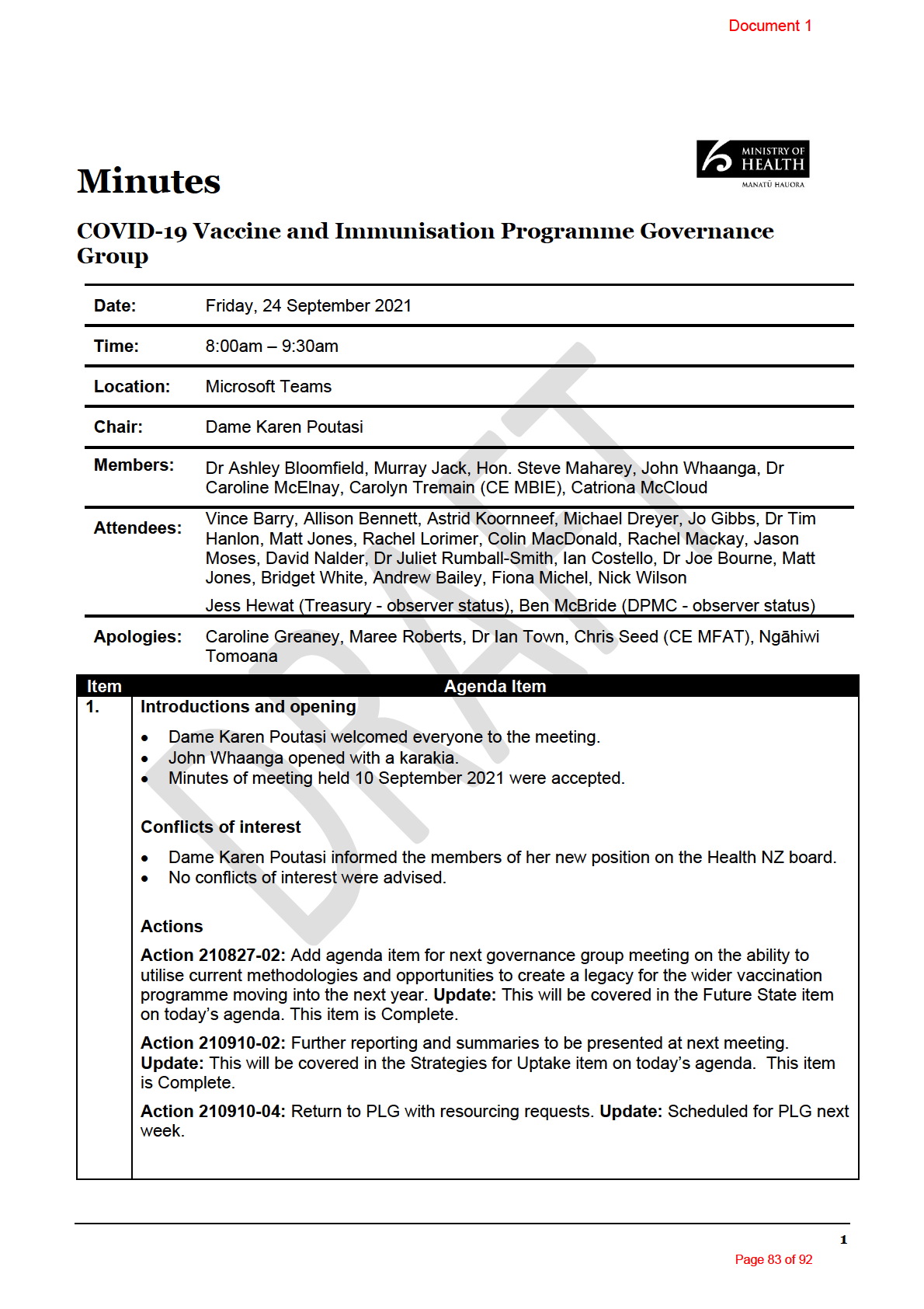
1982
ACT
INFORMATION
OFFICIAL
THE
UNDER
RELEASED
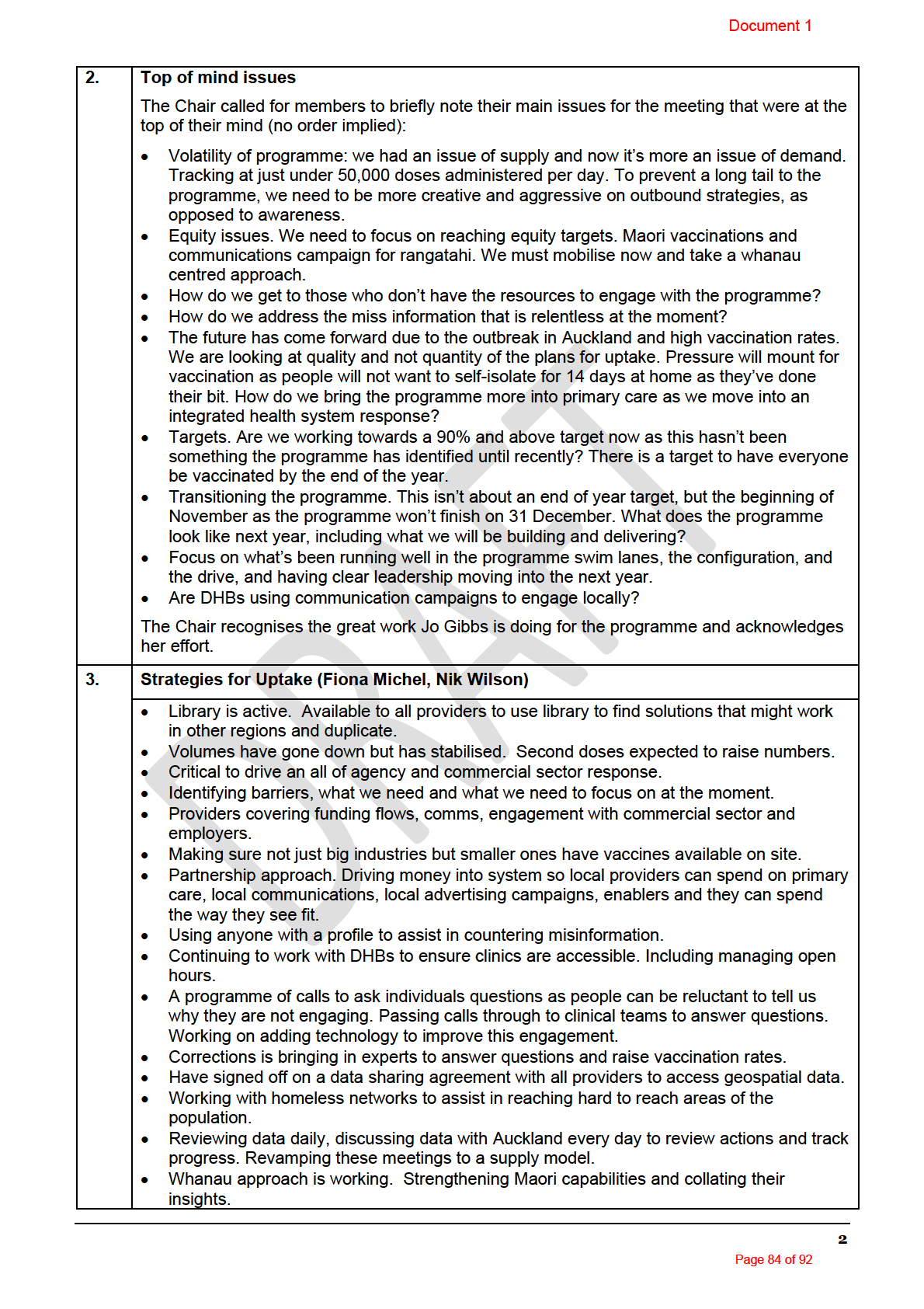
1982
ACT
INFORMATION
OFFICIAL
THE
UNDER
RELEASED
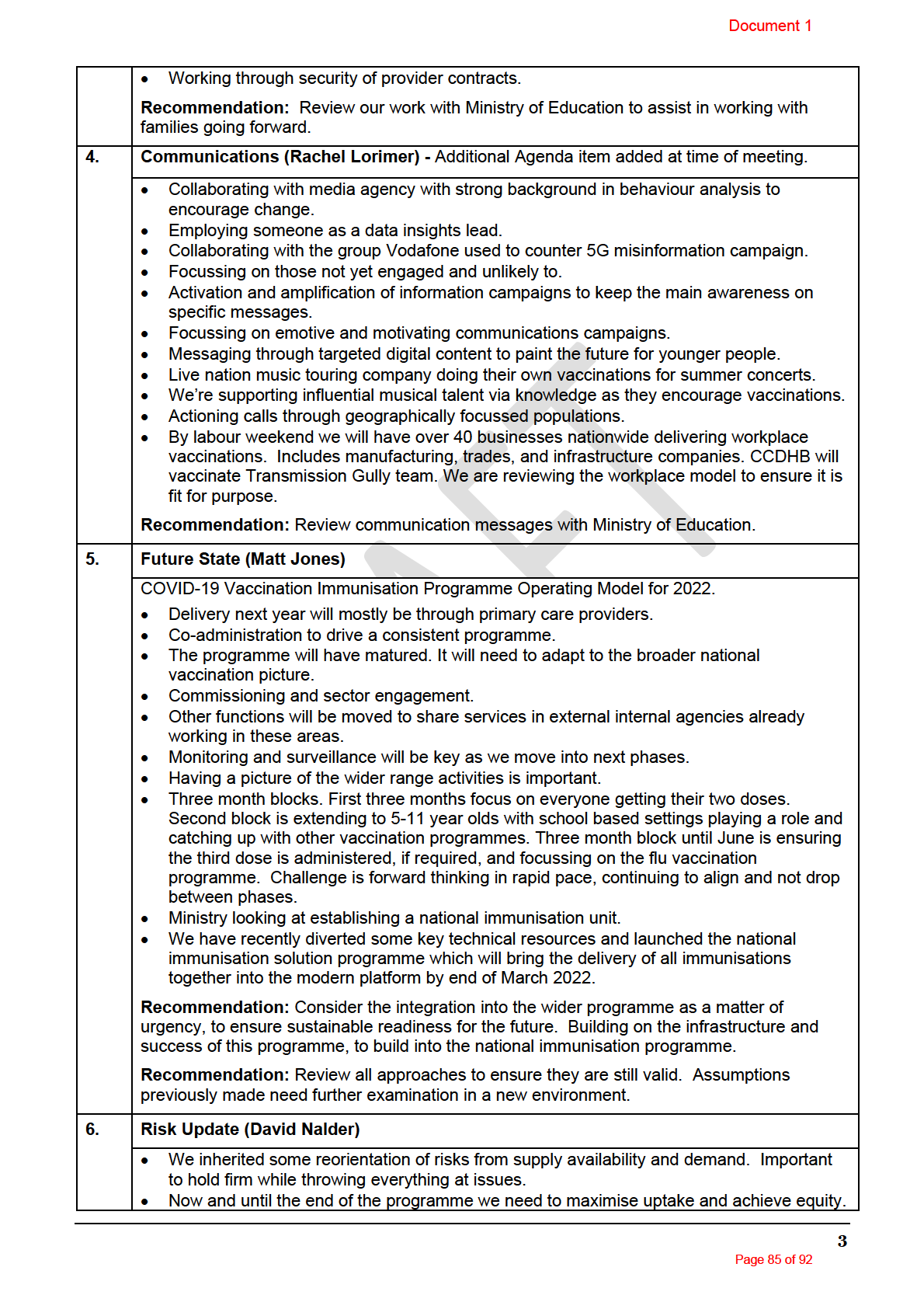
1982
ACT
INFORMATION
OFFICIAL
THE
UNDER
RELEASED
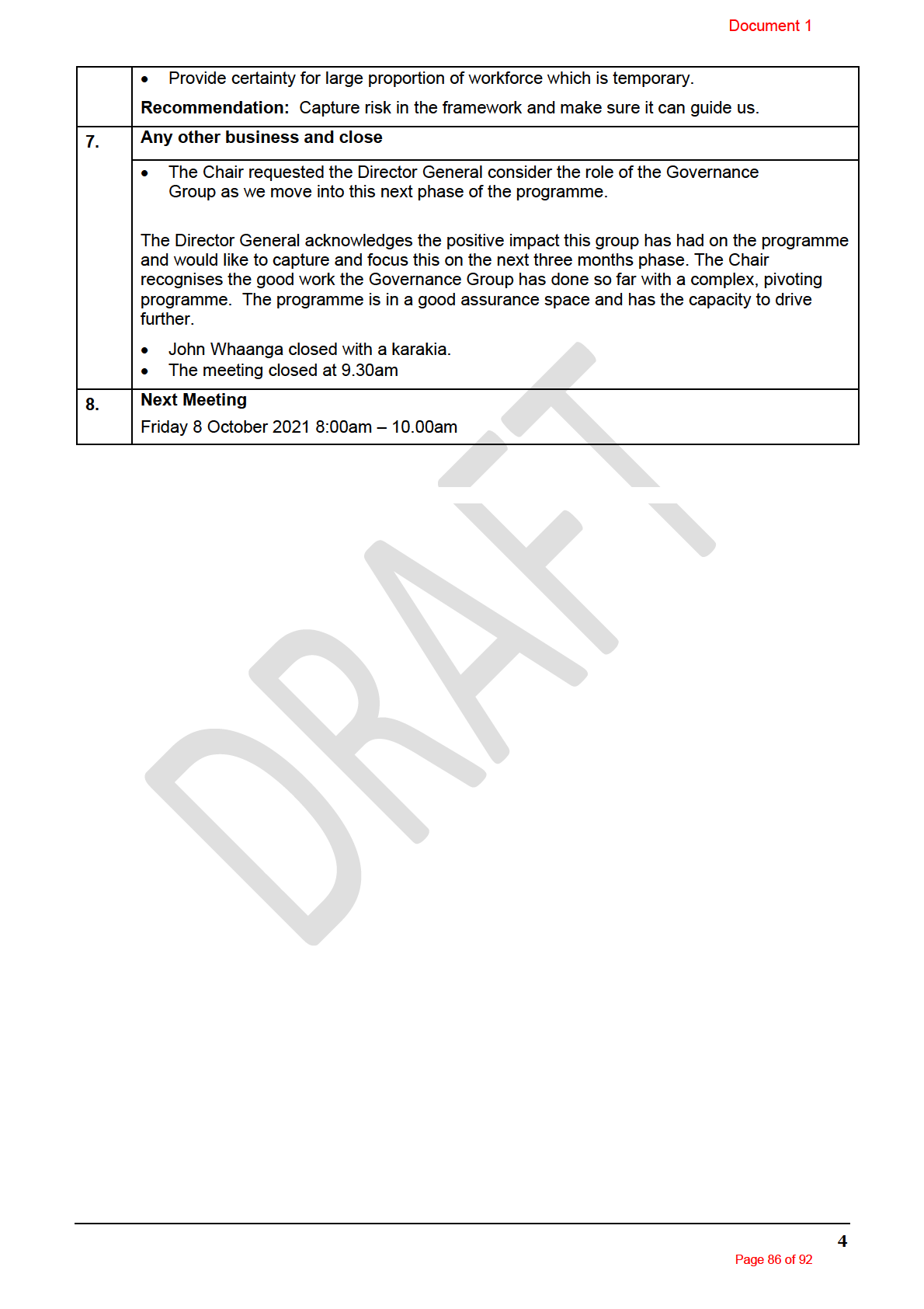
1982
ACT
INFORMATION
OFFICIAL
THE
UNDER
RELEASED

1982
ACT
INFORMATION
OFFICIAL
THE
UNDER
RELEASED
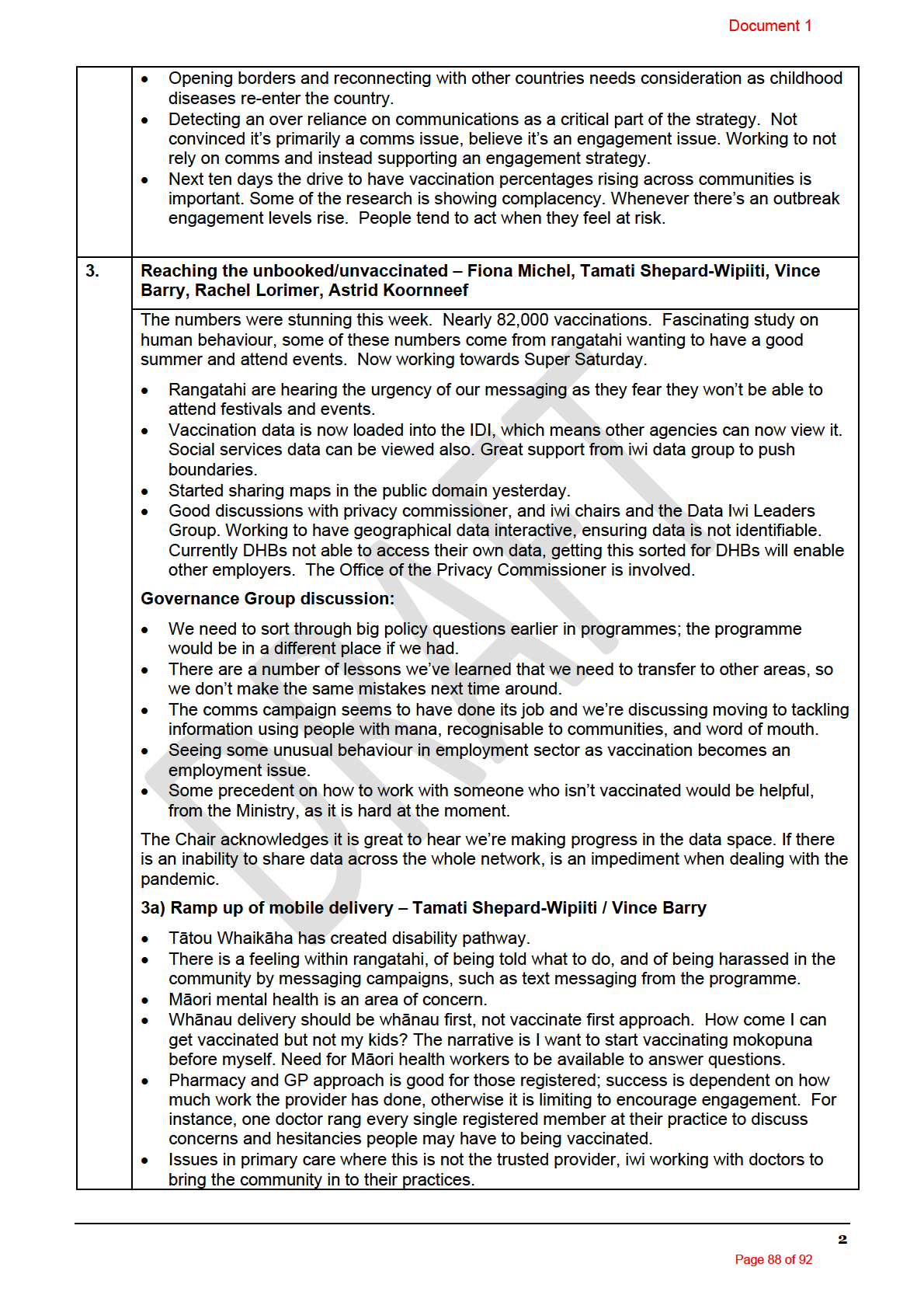
1982
ACT
INFORMATION
OFFICIAL
THE
UNDER
RELEASED
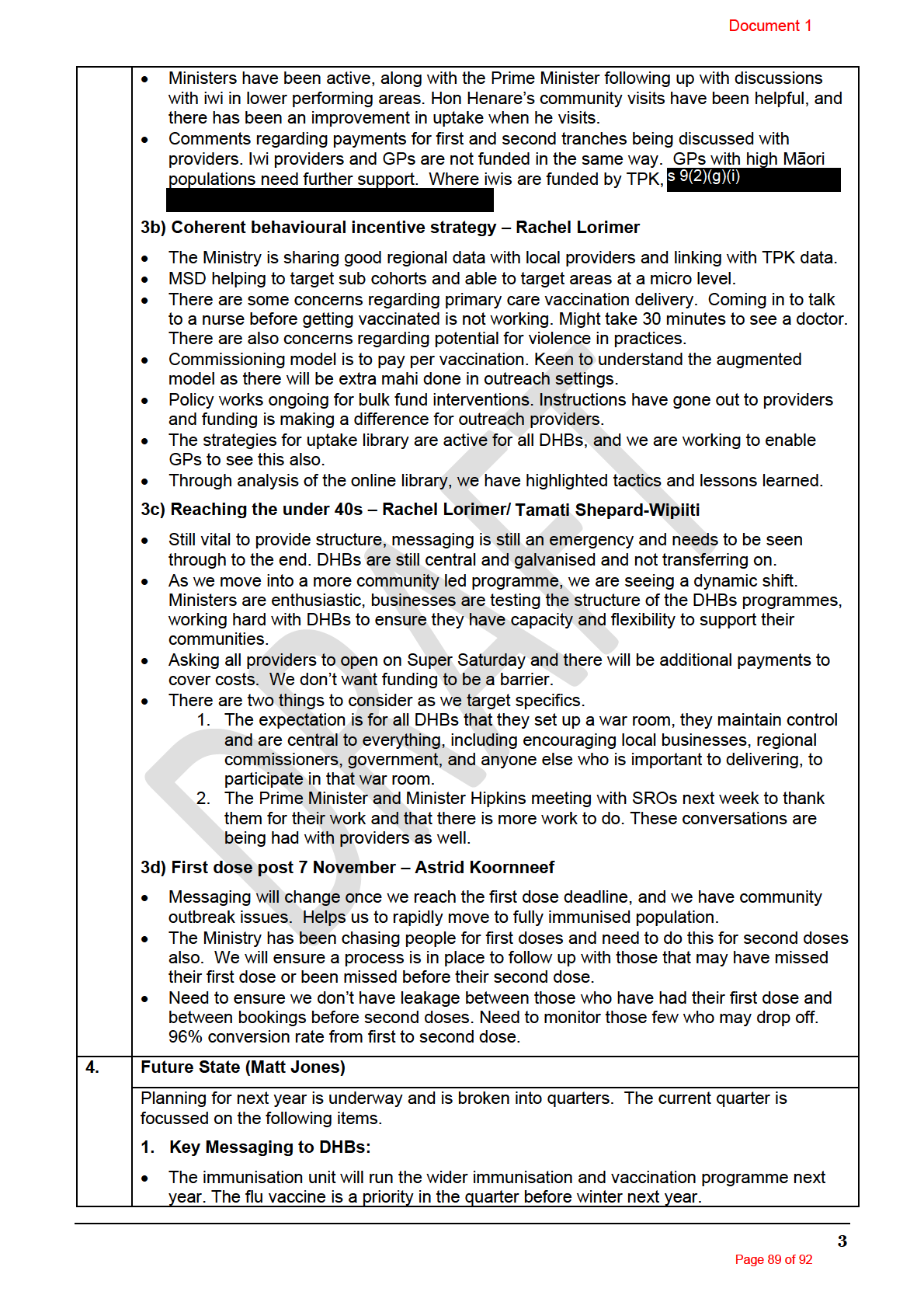
1982
ACT
INFORMATION
OFFICIAL
THE
UNDER
RELEASED
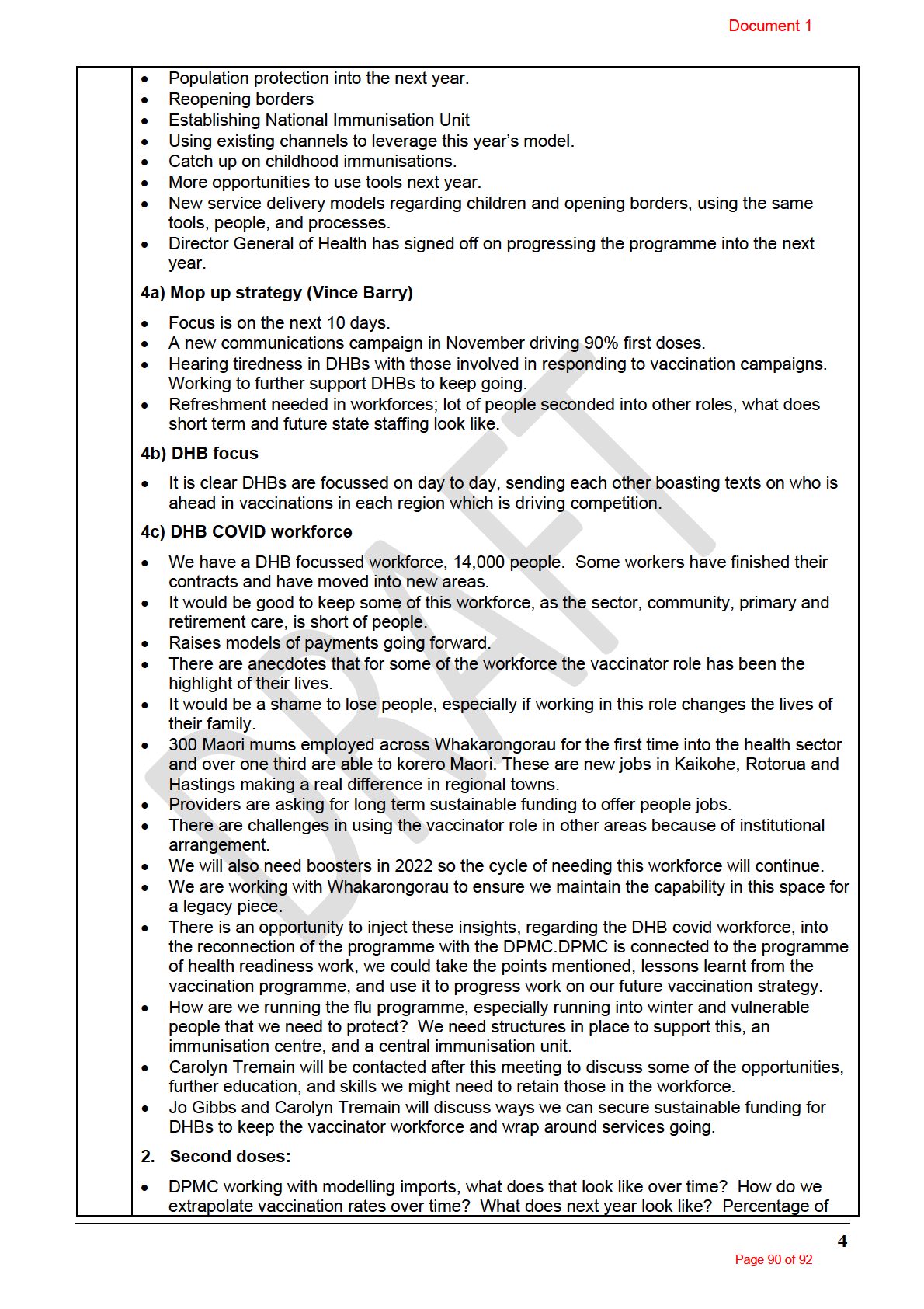
1982
ACT
INFORMATION
OFFICIAL
THE
UNDER
RELEASED
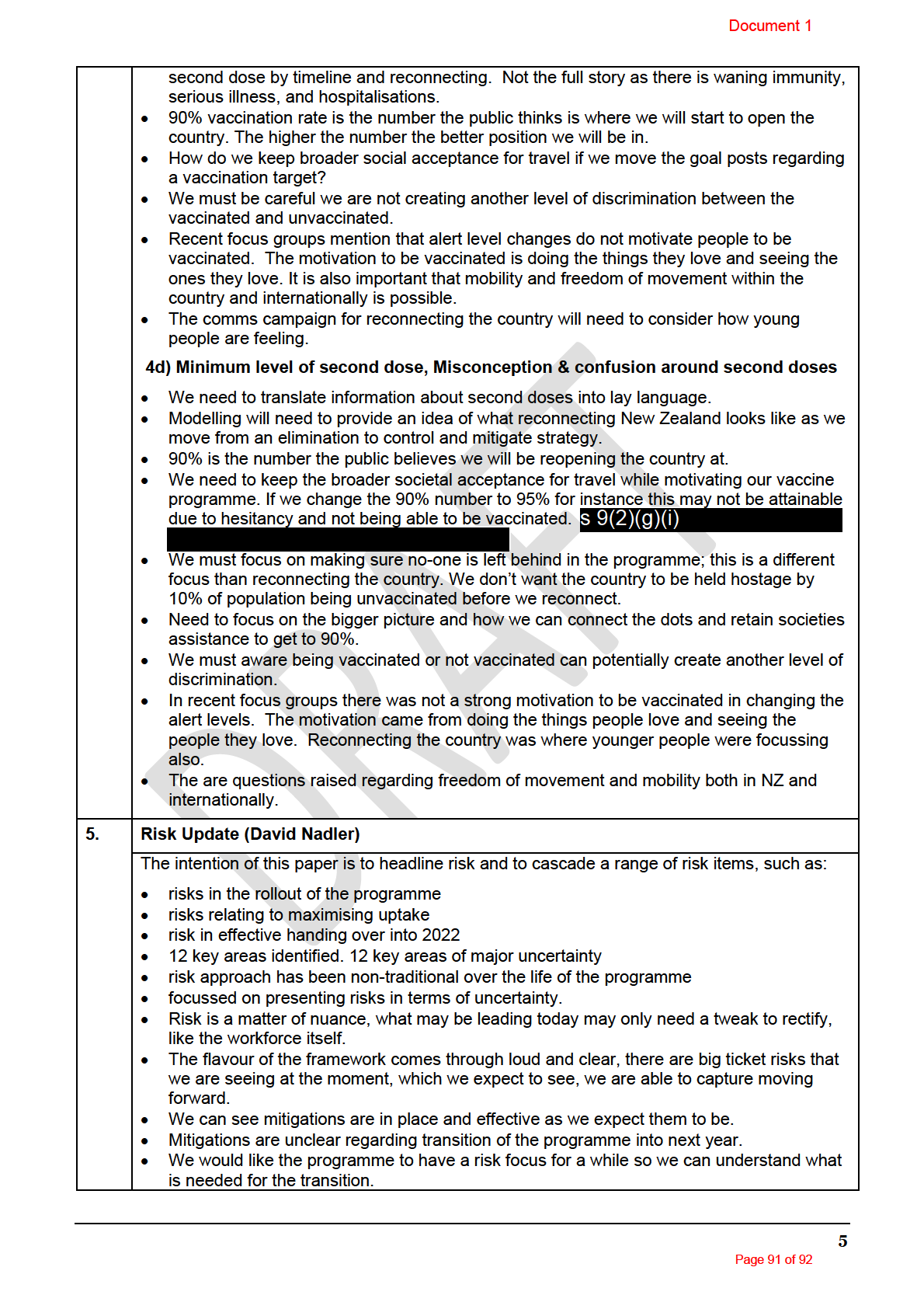
1982
ACT
INFORMATION
OFFICIAL
THE
UNDER
RELEASED

1982
ACT
INFORMATION
OFFICIAL
THE
UNDER
RELEASED


















